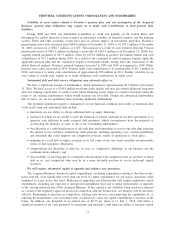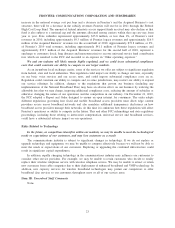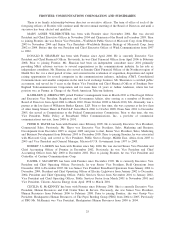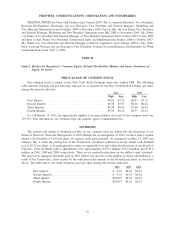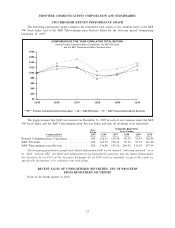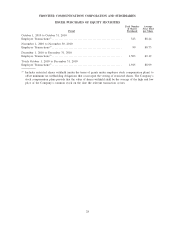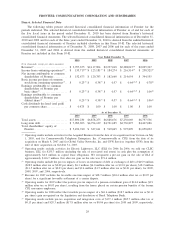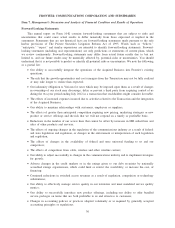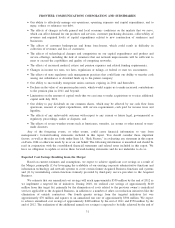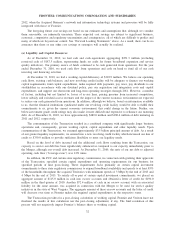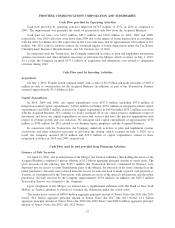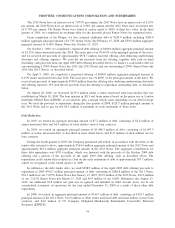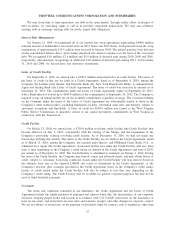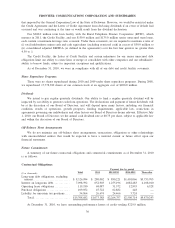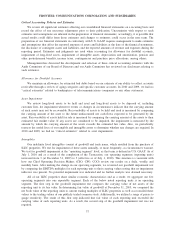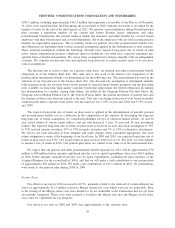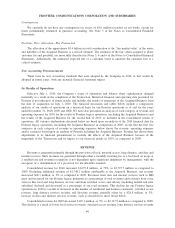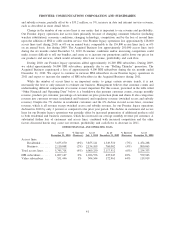Frontier Communications 2010 Annual Report Download - page 32
Download and view the complete annual report
Please find page 32 of the 2010 Frontier Communications annual report below. You can navigate through the pages in the report by either clicking on the pages listed below, or by using the keyword search tool below to find specific information within the annual report.•Our ability to effectively manage our operations, operating expenses and capital expenditures, and to
repay, reduce or refinance our debt;
•The effects of changes in both general and local economic conditions on the markets that we serve,
which can affect demand for our products and services, customer purchasing decisions, collectability of
revenues and required levels of capital expenditures related to new construction of residences and
businesses;
•The effects of customer bankruptcies and home foreclosures, which could result in difficulty in
collection of revenues and loss of customers;
•The effects of technological changes and competition on our capital expenditures and product and
service offerings, including the lack of assurance that our network improvements will be sufficient to
meet or exceed the capabilities and quality of competing networks;
•The effects of increased medical, retiree and pension expenses and related funding requirements;
•Changes in income tax rates, tax laws, regulations or rulings, or federal or state tax assessments;
•The effects of state regulatory cash management practices that could limit our ability to transfer cash
among our subsidiaries or dividend funds up to the parent company;
•Our ability to successfully renegotiate union contracts expiring in 2011 and thereafter;
•Declines in the value of our pension plan assets, which would require us to make increased contributions
to the pension plan in 2011 and beyond;
•Limitations on the amount of capital stock that we can issue to make acquisitions or to raise additional
capital until July 2012;
•Our ability to pay dividends on our common shares, which may be affected by our cash flow from
operations, amount of capital expenditures, debt service requirements, cash paid for income taxes and
liquidity;
•The effects of any unfavorable outcome with respect to any current or future legal, governmental or
regulatory proceedings, audits or disputes; and
•The effects of severe weather events such as hurricanes, tornados, ice storms or other natural or man-
made disasters.
Any of the foregoing events, or other events, could cause financial information to vary from
management’s forward-looking statements included in this report. You should consider these important
factors, as well as the risks set forth under Item 1A. “Risk Factors,” in evaluating any statement in this report
on Form 10-K or otherwise made by us or on our behalf. The following information is unaudited and should be
read in conjunction with the consolidated financial statements and related notes included in this report. We
have no obligation to update or revise these forward-looking statements and do not undertake to do so.
Expected Cost Savings Resulting from the Merger
Based on current estimates and assumptions, we expect to achieve significant cost savings as a result of
the Merger, principally (1) by leveraging the scalability of our existing corporate administrative functions and
information technology and network systems to cover certain former Acquired Business functions and systems
and (2) by internalizing certain functions formerly provided by third-party service providers to the Acquired
Business.
We estimate that our annualized cost savings will reach approximately $550 million by the end of 2012 as
we implement a targeted list of initiatives. During 2010, we realized cost savings of approximately $140
million from this target list, primarily by the elimination of costs related to the previous owner’s centralized
services applicable to the Acquired Business, in addition to a number of other cost reduction initiatives like the
elimination of outside contractors. Our fourth quarter savings from the targeted initiatives list was
approximately $76 million and equates to an annualized run rate of approximately $304 million. We expect
to achieve annualized cost savings of approximately $400 million by the end of 2011 and $550 million by the
end of 2012. The realization of the additional annual cost savings is expected to be fully achieved by the end of
31
FRONTIER COMMUNICATIONS CORPORATION AND SUBSIDIARIES


